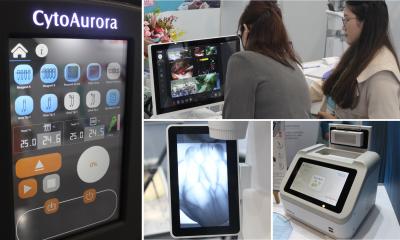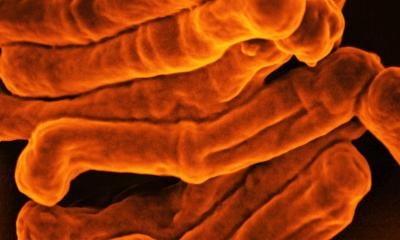
Image source: Shutterstock/Cryptographer
Article • Point-of-care testing
Emerging technologies in POCT
Considerable advances in point-of-care testing (POCT) devices are emerging from lab-on-a-chip platforms, innovations in smartphone-based technology and wearable technology. Cloud-based deep learning systems herald a future revolution.
Report: Bernard Banga, MD
The World Health Organization (WHO) has endorsed bedside diagnostics as the top research priority in response to the so-far 2-year long epidemic without let-up. The aim is to improve turnaround time and ease of use compared to the gold standard lab-based PCR test. These have included rapid antigen tests, alternate nucleic amplification methods and novel sensors in proximity to the patients.
POCT deployed in multiple clinical contexts in 2021
POCT is being rolled out in various healthcare settings in 2021. The most obvious applications are blood-glucose monitoring and pregnancy testing. ‘Widespread POC testing and diagnostic devices are available, including, but not limited to, glucose monitoring, pregnancy and infertility testing, infectious disease testing, cholesterol testing and cardiac markers,’ said Amit Saha, from the Stanford Genome Technology Center in California, USA. Today, blood gas analysis along with haemoglobin, prothrombin time and infectious disease testing are the dominant applications in the POCT market.
Looking to the future, tumour markers, flow cytometry (mainly for chemotherapy monitoring), endocrine function tests and therapeutic drug monitoring will all benefit from recent technology advances in the POCT field.
Technology advances change POCT applications
Greater sensitivity and specificity when detecting target analytes in small volumes overcomes several challenges encountered when using traditional POCT techniques
Amit Saha
Miniaturisation in chip technology, microfluidics and new biosensors have heralded the design of new systems for POCT. Lab-on-a-chip technology is one of the main drivers of POCT, especially in infectious disease diagnosis. This technology means various bioassays, such as microbiological culture, polymerase chain reaction (PCR) and enzyme-linked immunosorbent assays (ELISA), can now be used at the point of care.
Similarly, emerging microfluidic technologies include a set of miniaturised components allowing chemical or biological samples to be analysed at the microscopic level. Microfluidic-based POCT devices are widely used in molecular biology as well as in chemical and biochemical analysis. They enable detection and fluid regulation in a single unit. ‘Greater sensitivity and specificity when detecting target analytes in small volumes overcomes several challenges encountered when using traditional POCT techniques,’ Saha said. POCT currently centres around two technologies: lateral flow assay (LFA) and nucleic acid amplification. The first is used in pregnancy testing; testing for HIV, herpes simplex virus, hepatitis, infectious diseases (Ebola, dengue, malaria, Zika virus) and respiratory infections; and for diagnosis and prognosis in conditions such as cancer, by identifying specific biomarkers. The second, much more sensitive and specific, is based on PCR on a chip and isothermal amplification. Nucleic acid amplification can be used to detect a whole array of infectious diseases, such as Mycoplasma pneumonia, Bordetella pertussis, Legionella pneumonia, Influenza A virus, SARS, Legionella, Aspergillus, West Nile Virus and, now, SARS-CoV-2.
A seventh format joins POCT
POC device manufacturers are continually looking for ways to design products that deliver greater user comfort in a cost-effective manner. POCT relies on six main formats: bench-top, monitoring, transportable, portable, handheld and disposable. In recent years, the latest advances have seen the launch of a seventh: smart devices with smartphones and wearable devices. Mobile POCT uses sensors to detect signals from samples in vitro, whereas wearable POCT detects signals directly on the body. Both systems then send quantified results to the clinic via wireless communication. Various body fluids such as tears, urine, blood, sweat and saliva can be used to analyse metabolites, hormones, proteins, viruses and bacteria.
Smartphones act as minicomputers for sensitive and specific data quantification with built-in sensors, high resolution cameras, rapid wireless connectivity and the ability to use various software and apps. This means they can function as standalone sensors and detectors in mobile POCT, Saha pointed out.
Similarly, wearable POCT devices can be physical sensors used to acquire samples from the skin, eye or mouth with minimal invasion. They come in various forms, such as tattoos, patches, bands, watches, spectacles and contact lenses, and can be integrated with smartphones for data capture. This type of testing is especially important for patients suffering from critical conditions, as they can monitor their health constantly without the need to go to hospital, or for trained personnel.
Artificial intelligence and machine learning
Artificial intelligence (AI), machine learning (ML) and neural networks are now starting to be integrated into POCT. These AI modules have demonstrated their value in diagnostics studies. However, the accuracy of test apps varies greatly and relying on these apps is cautioned against. The future is bright. Since samples can be digitised directly at the point of care, advanced digital diagnostic techniques, such as sample analysis using medical AI algorithms, can be deployed outside high-end laboratories. ‘Hence POC digital microscopy, supported by automated digital image analysis and AI, might be deployed for routine microscopy diagnostics on samples harvested during cancer surgery, or on parasitology samples with an emphasis on potential areas of application in low-resource settings,’ added Oscar Holmström from the Faculty of Medicine at the University of Helsinki, Finland.
POCT and Covid-19
Most promising SARS-CoV-2 POCT methods: immunoassays for antibody and antigen detection, RT-PCR as the gold standard, isothermal amplification and CRISPR/Cas9 genome editing technology as an emerging technique. Due to growing confirmed Covid-19 cases globally, rapid and reliable POCT is needed urgently for early detection. A reliable POCT device could reduce transportation, risk of spreading infection, strain on healthcare, and cost of care. Despite outbreaks caused by infectious viral diseases such as MERS, SARS, and Ebola, existing POCT platforms were not sufficiently ready to address the Covid-19 viral threat. However, in 2020 great efforts were made in POCT to improve Covid-19 detection.
Surging POCT demand
POCT systems account for 30% of in-vitro diagnostics. According to Reportlinker, the global POCT market is anticipated to experience rapid growth in a few years – estimated to reach USD 50.6 billion by 2025, from USD 29.5 billion in 2020 – a CAGR of 11.4%. Fifteen key market players: Abbott Laboratories (US), Roche Holding AG (Switzerland), Siemens Healthineers AG (Germany), Danaher Corporation (US), Becton Dickinson and Company (US), Johnson & Johnson (US), Instrumentation Laboratory Company (US), PTS Diagnostics Inc (US), Quidel Corporation (US), Chembio Diagnostic Systems Inc (US), Sekisui Diagnostics LLC (US), Nova Biomedical Corporation (US), EKF Diagnostics Holdings plc (UK), AccuBioTech Co., Ltd (China) and Trinity Biotech Plc (Ireland). Anticipated 2022 revenues by product in the POCT market: glucose monitoring (39%), blood gas analysis (15%), cardiac markers (13%), infectious diseases (8%), pregnancy & fertility testing (5%), alcohol & drug abuse (5%), haemoglobin testing (4%), cholesterol testing (3%), urine chemistry (3%), tumour markers (3%), others (2%).
15.11.2021










